 advertisements advertisements
|

|
'Not that into peace doves': The Apollo-Soyuz patch NASA rejected
July 15, 2025 — Fifty years ago on July 15, 1975, three NASA astronauts and two Russian cosmonauts lifted off to meet up in orbit for the first time.
Representing the joint Apollo-Soyuz Test Project (ASTP, or Soyuz-Apollo in the Soviet Union), both crews wore a cloth patch that featured the artwork of an accomplished space artist. The design that flew, however, was not the astronauts' first pick. That patch idea was rejected because Paul Calle opted to highlight the détente nature of the international handshake in space.
"Our first choice for a patch ... has been disapproved," wrote Deke Slayton, the mission's docking module pilot, in a letter to Calle. "It seems the powers that be are not that into peace doves and olive branches at the moment."
It was an odd objection, given that Soviet General Secretary Leonid Brezhnev later described the ASTP flight as "a symbol of the ... improvement of Soviet-U.S. relations on the basis of the principals of peaceful coexistence," and Gerald Ford welcomed continued cooperation in space "to ensure peace."
'You forgot your patch...'
Paul Calle was not new to capturing the essence of space history in the making. One of the first members of NASA's art program, which recruited artists to document human spaceflight, Calle sketched the Apollo 11 crew as they had breakfast and donned their spacesuits prior to lifting off on the first mission to land astronauts on the moon. He also designed the popular U.S. postage stamp that celebrated that achievement in 1969.
Calle got to know the ASTP crew — NASA astronauts Thomas Stafford, Vance Brand and Slayton and Soviet cosmonauts Alexei Leonov and Valery Kubasov — while accompanying them to the Soviet Union and sketching them as they trained in Star City, outside of Moscow.
So when asked by the American crew members to design their patch, Calle came back with concepts that prominently featured a white dove holding an olive branch in its mouth. Other versions incorporated the peace sign, as well as a rendering of Earth showing both the United States and the Soviet Union, the flags of the U.S. and USSR and his simplified illustration of the Apollo and Soyuz docked together.
Some of Calle's designs included all of the crew members' names, some only had the American astronauts' names and others had no names at all.
But none of the versions were to NASA's liking.
"We would be happy to see any new sketches you would come up with," wrote Slayton. "The top choice would be heavy on red, white, blue, and gold colors, if that is any value to you."
Calle, though, was more drawn by the call of the West than by the cooperation with the East.
"He had just started his career painting and drawing the American West, so he really wasn't taking any more illustration assignments," said Chris Calle, Paul Calle's son and a successful space artist in his own right. "He really wasn't doing much for NASA [any longer], so I think that's why, when they came back balking about the patches with the doves and olive branches, he just didn't have the time to put towards that."
That said, Calle was not completely done with the patch. While attending the U.S. launch, Calle drew a cartoon of the Apollo liftoff with him running after it and holding up his "disapproved" insignia with the caption, "Wait... you forgot your patch of doves and olive branches!"
Rejects and revivals
Calle's patch design was not the only one ruled out by NASA's officials.
At first, Stafford, Brand and Slayton chose a design from a contest among the U.S. space program's workforce. The winner, Jean Pinataro of North American Rockwell (the prime contractor for the Apollo command module), came up with a concept that the astronauts liked but the agency's leaders rejected it for not having enough "international significance" (unofficially, it was also said to be "cartoonish").
That led to NASA accepting the cost of hiring an artist from the NASA art program and Calle being invited to offer his ideas. It also resulted in the patch that flew.
When Calle stepped away, the decision was made to repurpose the work of Bob McCall, an artist who had designed the Apollo 17 mission patch and in 1974 had painted the scene of the Apollo and Soyuz spacecraft nearing a docking. McCall would go on to create similar art for a pair of postage stamps issued in the United States and Soviet Union while Pinataro adapted McCall's original painting as the central image of the U.S. ASTP emblem.
The cosmonauts had their own design — in fact it was the first Russian mission patch to involve the crew's input — but wore both their own and the U.S. patch during their six days in space.
Today, 50 years later, the McCall-inspired design, the cosmonauts' patch and the Apollo-Soyuz program insignia are used interchangeably to represent the mission. Calle's designs have been largely forgotten, but are now getting a revival for the golden anniversary.
"I wanted to reimagine them. Not redo them, but bring them to life," said Chris.
Working with a fellow artist, Tim Gagnon, who created a number of the mission patches worn by space shuttle and International Space Station crews, Chris has begun the process of having a limited number of embroidered patches produced that are based on his and his late father's ideas.
Chris primarily focused on Calle's dove and olive branch design.
"It certainly keeps to the spirit of my dad's original idea," said Chris.
Chris Calle asks readers to contact him via his website to express interest and be kept informed when the limited edition Apollo-Soyuz patches are available. |
|
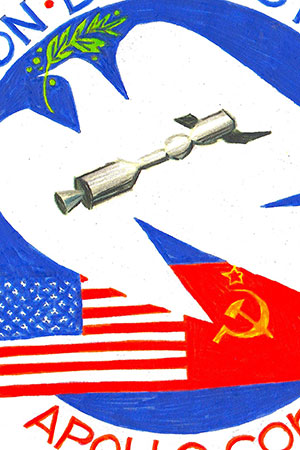
Space artist Paul Calle submitted this mission patch design to the American crew of the Apollo-Soyuz Test Project. The astronauts liked it, NASA "disapproved" of the peace dove. (Calle Space Art)
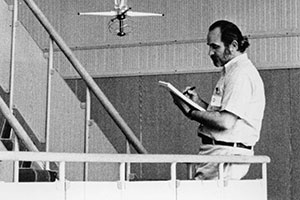
Paul Calle sketching a scene near a Soyuz simulator at the Gagarin Cosmonaut Training Center in Star City in 1974. (Calle Space Art)
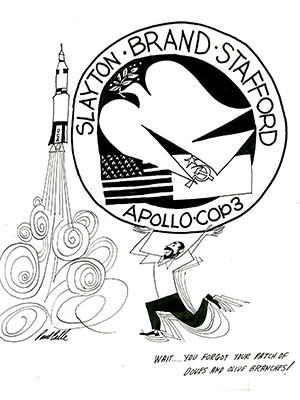
Paul Calle's July 1975 cartoon poking fun at his own reject mission patch for the joint Apollo-Soyuz Test Project. (Calle Space Art)
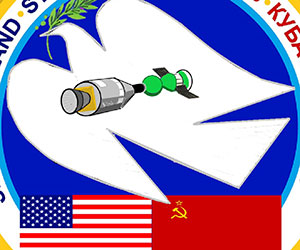
Chris Calle, working with fellow artist Tim Gagnon, has reimagined his father's ASTP patch designs and are preparing to put them into production as a limited edition offering. (Calle Space Art) |
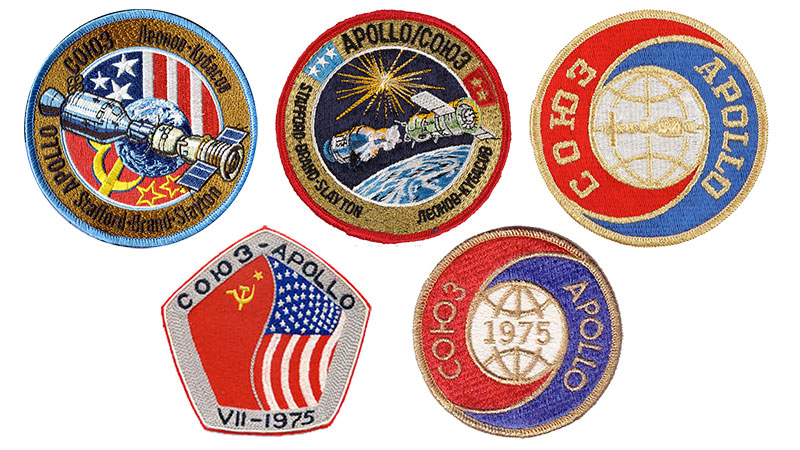
Apollo-Soyuz Test Project (ASTP) patches, from top left to right: 2021 embroidered replica of Jean Pinataro's original design; the Soviet Soyuz 18 crew patch; the Apollo-Soyuz Test Project crew patch; souvenir ASTP program patch; and ASTP program patch. (AB Emblem/Roscosmos) |
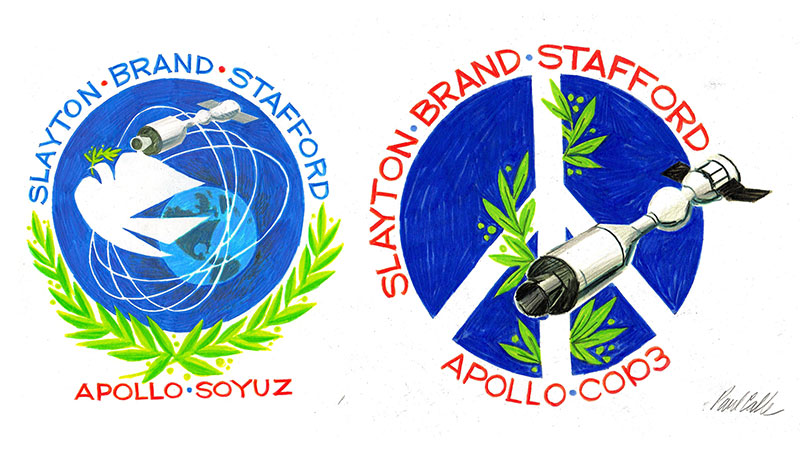
Artist Paul Calle's alternate designs for the Apollo-Soyuz Test Project crew patch featuring a dove, olive branch and peace symbol. (Calle Space Art) |
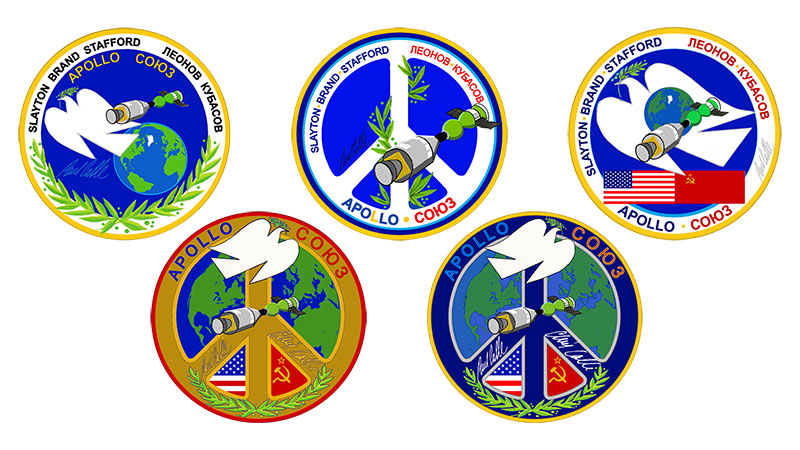
Chris Calle's reimagined Apollo-Soyuz patches, based on his father's original ideas and created together with artist Tim Gagnon. (Calle Space Art) |
|

© collectSPACE. All rights reserved.
|
|

|

|
